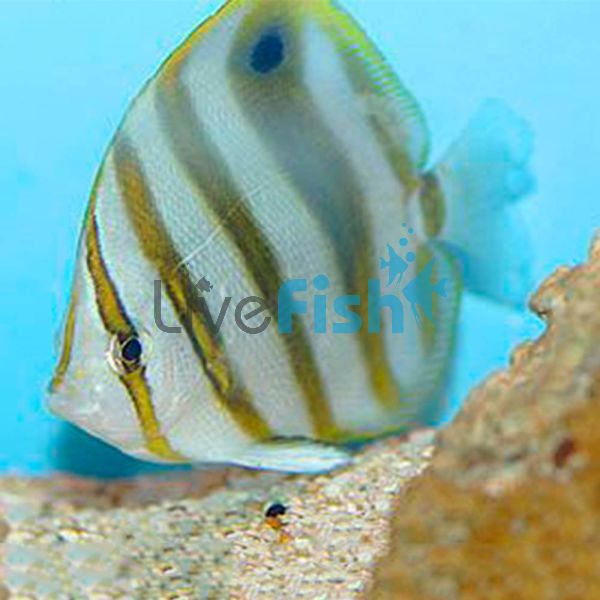Ocellate Butterflyfish MED
Ocellate Butterflyfish - Parachaetodon ocellatus
The Ocellate Butterflyfish is an attractive species of decorative Butterflyfish that is well suited to intermediate aquarium owners. It easily adapts to large community aquariums and is currently the only classified fish in its genus.
Ocellate Butterflyfish
This Butterflyfish is white with 5 yellow-brown vertical stripes running along its body and owns a false eyespot on the base of its tail. Rarely seen in the aquarium trade they will make a stunning addition to big fish-only tank environments.
These fish will form pairs during the breeding season but have been seen to school in large numbers as adults around muddy deep areas. No known success has been had when attempting to breed this species in captivity. Although they have been known to spawn in larger public aquariums.
Ocellate Butterflyfish have a distinctive vertical band running through their eyes which is thought to have developed to confuse predators. This seems especially likely when combined with the false eyespot located on its tail.
These fish are originally found all over the Indo-Pacific region ranging from Fiji and Sri Lanka over to the Great Barrier Reef and New South Wales. They inhabit shallow bays and can be found at depths down to 30 meters. They love hanging around on flat-bottomed seagrass beds.
Tank Recommendations for Ocellate Butterflyfish
The smallest tank size required for this species is 280 liters and will need to contain plenty of wide-open swimming space.
They should ideally be kept in fish-only tank environments but can be kept in certain reef aquariums if caution is taken. No specific lighting or water movement is necessary.
Suitable Tank Buddies
The Ocellate Butterflyfish are a peaceful species and as such should be kept with other peaceful non-aggressive fish. As mentioned before reef environments should be avoided as they have been known to eat small decorative invertebrates.
Usually Compatible
This species will do great with both large and dwarf species of Angelfish along with Frogfish and Batfish. Blennies, Cardinalfish, and Boxfish would all make wonderful choices for tank buddies. Other great options could include Dragonettes, Goatfish, and Gobies. Grunts, Lionfish, and Hawkfish are other excellent tank mates too. Parrotfish and Pufferfish are also a good fit.
Sometime Compatible
Take caution when combining them with Wrasses, Triggerfish, and Tangs. Squirrelfish and Rays should also have a close eye kept on them if attempting to house them with Butterflyfish. Other species to watch out for include Eels, Fancy Damselfish and Filefish. Small species of crustaceans and invertebrates may be preyed upon. Be careful when keeping them with other species of Butterflyfish especially ones that look similar.
Rarely Compatible
Avoid keeping this species with larger predators such as Groupers and Sharks. Snappers should also be avoided for similar reasons. Smaller more docile species such as Pipefish and Seahorses may be too shy to come out and eat in the presence of a boisterous swimmer like the Ocellate Butterflyfish.
Feeding your Ocellate Butterflyfish
These fish are omnivorous in the wild and should be supplied with a meaty diet supplemented by flake foods containing Spirulina. They are well known for being problematic to begin feeding. Small clams can be added to the tank in half-shells to entice feeding as well as pressing soft foods onto the dead coral skeleton. Feed them several times daily at first until they are comfortable eating.
| Scientific Name | Parachaetodon ocellatus |
|---|---|
| Care Level | Moderate |
| Common Names | The Ocellate Butterflyfish is also known as the Ocellate Coralfish, the Eye-Spot Coralfish and the Sixspine Butterflyfish. |
| Diet | Omnivore |
| Fish Family | Chaetodontidae |
| Lifespan (years) | 8 |
| Max. Length (cm) | 18 |
| Min. Tank Volume (l) | 280 Liters |
| Origin | Indo-Pacific |
| Reef Safe | With Caution |
| Sociability | Peaceful |
| Venomous | No |
| Water Conditions | 22-27° C (72-82° F), dKH 8-12, pH 8.0-8.5, sg 1.020-1.026 |




